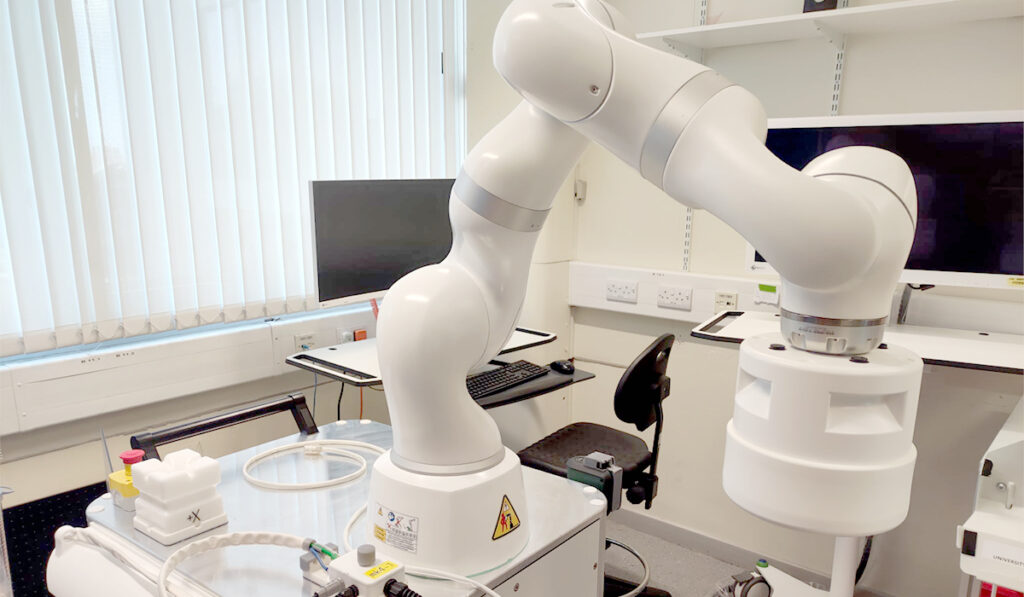Discoveries in Medicine presents a two-part overview of the work of Keith L. Obstein, M.D., who, along with Pietro Valdastri, Ph.D., is principal investigator on a phase 1 trial as part of a a VISE collaboration between departments and universities.
Obstein is a VUMC gastroenterologist and professor of mechanical engineering at Vanderbilt University. Valdastri is a former assistant professor of mechanical engineering at Vanderbilt and now chairs the Robotics and Autonomous Systems at University of Leeds. Together, they run the Science and Technology of Robotics in Medicine and are working toward the development of an advanced robotic colonoscopy system — from concept through clinical trials.
Obstein reports that the team’s novel colonoscopy platform is proving viable in early clinical trials — an exciting development in the field.
Here, we catch up with Obstein and the progress his team is making as the platform moves toward regulatory approval.
Conventional Limitations
Discoveries: Tell us about the dream to create a better system for diagnostic and therapeutic colonoscopy. What led you to take on this ambitious initiative?
Obstein: It started with my undergraduate studies in biomedical engineering, which eventually led me to pursue a career in gastroenterology. My fellowship program introduced me to the world of device development, inspiring me to focus on developing novel endoscopic technologies.
“As the prevalence of colorectal cancer continues to rise, the need for better colonoscopy systems has only become more apparent.”
Colonoscopies have remained relatively unchanged since the 1960s. While the procedure is relatively safe, there are inherent limitations — the need for anesthesia, patient discomfort due to looping, procedure-related trauma and infection, and variability among providers — due to the unintuitive drive mechanism and mechanical design of conventional colonoscopes. As the prevalence of colorectal cancer continues to rise, the need for better colonoscopy systems has only become more apparent.
We recognized that to overcome these limitations, there would have to be a dramatic transformation in both endoscope design and technique. The engineering challenges are mind-boggling, ranging from the drive mechanism to the sensing and guidance software.
A Novel Platform
Discoveries: How does your colonoscopy system overcome these limitations?
Obstein: The system was designed to address the limitations of conventional colonoscopy. Uniquely, it’s composed of a handheld controller, a robot manipulator with magnetic end effector, and an ultra-compliant magnetic flexible endoscope to maintain the diagnostic and therapeutic functionality of current colonoscopes.
To reduce the learning curve, we incorporated an algorithm that allows for localization of the endoscope and consequently computes the desired robot motion. As a result, the robotic arm does not need to be directly in line with the desired direction to move the endoscope tip. By moving and rotating the arm around the patient, we can move the endoscope in all possible directions.
In other words, combining autonomous function and robotic assistance makes the difficult task of endoscope navigation much easier.
“We believe the system will prove to be easier to use, safer, and more cost-effective than conventional colonoscopy.”
Moreover, to avoid constant pulling of the magnets relative to one another, we arranged them in a configuration such that the external magnet north pole is directed towards the endoscope tip, while the internal magnet is orientated in the opposite direction. With this configuration, rotations on the external magnet create opposing rotations on the endoscope tip, stabilizing the endoscope by active control of the magnetic link via the robotic arm.
We believe the system will prove to be easier to use, safer, and more cost-effective than conventional colonoscopy.
Discoveries: What makes a magnetic flexible endoscope better than a conventional endoscope?
Obstein: The magnetic flexible endoscope is driven by magnetic coupling to enable front-pull actuation of the endoscope by its tip with the ultra-compliant insertion tube passively following. This forward drive mechanism prevents buckling of the insertion tube, looping, and colon-wall stress, lowering the risk of perforation, colon-wall trauma and pain during the procedure. The orientation of the robotic arm is the result of a complex 3D model of the magnetic fields produced by the two magnets and their interaction. This allows for implementation of supervised autonomy — semi-autonomous maneuvers — and ergonomic control mechanisms.
First‐in‐Human Trial
Discoveries: Where are you now in the testing of the system?
Obstein: We recently completed our first-in-human clinical trial to confirm system safety and tolerability of the system. In this trial, which included five patients, we observed that the system performed as intended and without any adverse events. There were no perforations, colon-wall trauma, or bleeding complications. The patients were awake during the procedure, and all tolerated the exam remarkably well.
Read part two of the series here.





